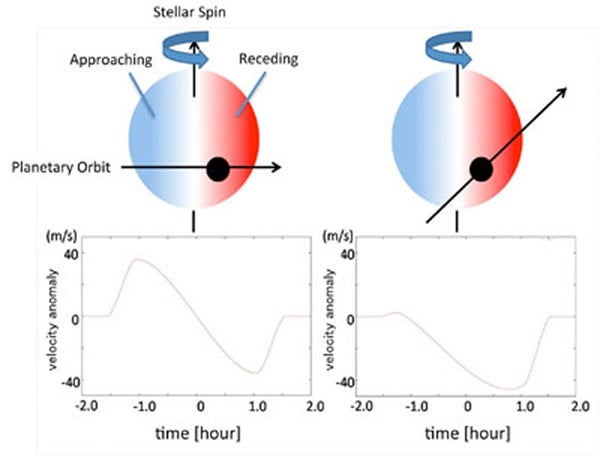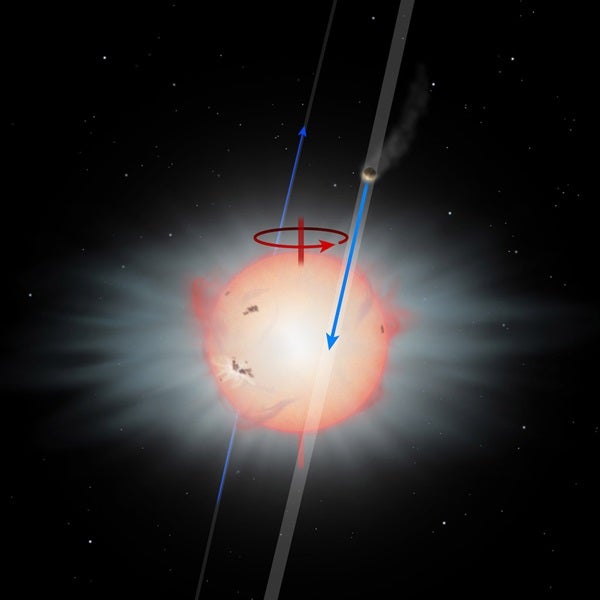Since the discovery of the first exoplanet around a normal star in 1995, scientists have identified more than 500 exoplanets, nearly all of which are giant planets and most of which closely orbit their host stars. Accepted theories propose that these giant planets originally formed from abundant planet-forming materials far from their host stars and then migrated to their current close locations. Different migration processes have been suggested to explain close-in giant exoplanets.
Disk-planet interaction models of migration focus on interactions between the planet and its protoplanetary disk. Sometimes interactions between the protoplanetary disk and the forming planet result in forces that make the planet fall toward the central star. These models predict that the spin axis of the star and the orbital axis of the planet will be in alignment with each other.
Planet-planet interaction models of migration have focused on mutual scatterings among giant planets during the creation of two or more giant planets within the protoplanetary disk. Although some of the planets scatter from the system, the innermost one may establish a final orbit close to the central star. Another planet-planet interaction scenario, Kozai migration, postulates that the long-term gravitational interaction between an inner giant planet and another celestial object may alter the planet’s orbit, moving an inner planet closer to the central star. Such planet-planet migration scenarios could produce an inclined orbit between the planet and the stellar axis.
Overall, the inclination of the orbital axes of close-in planets relative to the host stars’ spin axes emerges as an important observational basis for supporting or refuting migration models upon which theories of orbital evolution center. A research group led by astronomers from the University of Tokyo and NAOJ concentrated its observations with the Subaru Telescope on investigating these inclinations for two systems known to have planets — HAT-P-11 and XO-4. The group measured the Rossiter-McLaughlin (RM) effect of the systems and found evidence that their orbital axes incline relative to the spin axes of their host stars.
The RM effect refers to apparent irregularities in the radial velocity or speed of a celestial object in the observer’s line of sight during planetary transits. Unlike the spectral lines that are generally symmetrical in measures of radial velocity, those with the RM effect deviate into an asymmetrical pattern. Such apparent variation in radial velocity during a transit reveals the sky-projected angle between the stellar spin axis and planetary orbital axis. Subaru Telescope has participated in previous discoveries of the RM effect, which scientists have investigated for approximately 35 exoplanetary systems thus far.
In January 2010, a research team led by the current team’s astronomers from the University of Tokyo and the NAOJ used the Subaru Telescope to observe the planetary system XO-4, which lies 960 light-years away from Earth in the Lynx region. The system’s planet is about 1.3 times as massive as Jupiter and has a circular orbit of 4.13 days. The team’s detection of the RM effect showed that the orbital axis of the planet XO-4 b tilts to the spin axis of the host star. Only the Subaru Telescope has measured the RM effect for this system so far.
In May and July 2010, the current research team conducted targeted observations of the HAT-P-11 exoplanetary system, which lies 130 light-years from Earth toward the constellation Cygnus. The Neptune-sized planet HAT-P-11 b orbits its host star in a non-circular (eccentric) orbit of 4.89 days and is among the smallest exoplanets ever discovered. Until this research, scientists had only detected the RM effect for giant planets. The detection of the RM effect for smaller-sized planets is challenging because the signal of the RM effect is proportional to the size of the planet — the smaller the transiting planet, the fainter the signal.
The team took advantage of the enormous light-collecting power of the Subaru Telescope’s 8.2-meter mirror as well as the precision of its High Dispersion Spectrograph. Their observations not only resulted in the first detection of the RM effect for a smaller Neptune-sized exoplanet, but also provided evidence that the orbital axis of the planet inclines to the stellar spin axis by approximately 103° in the sky.
The current team’s observations of the RM effect for the planetary systems HAT-P-11 and XO-4 have shown that they have planetary orbits highly tilted to the spin axes of their host stars. The latest observational results about these systems, including those obtained independently of the findings reported here, suggest that such highly inclined planetary orbits may commonly exist in the universe. Planet-planet interaction models of migration, whether caused by planet-planet scattering or Kozai migratio, could account for their migration to the present locations.
However, measurements of the RM effect for individual systems cannot definitively discriminate between the migration scenarios. Because different migration models predict different distributions of the angle between the stellar axis and planetary orbit, developing a large sample of the RM effect enables scientists to perform statistical analyses to support the most plausible migration process. A sample’s inclusion of the measurements of the RM effect for such a small-sized planet as HAT-P-11 b will play an important role in understanding the formation and migration history of planetary systems.
Since the discovery of the first exoplanet around a normal star in 1995, scientists have identified more than 500 exoplanets, nearly all of which are giant planets and most of which closely orbit their host stars. Accepted theories propose that these giant planets originally formed from abundant planet-forming materials far from their host stars and then migrated to their current close locations. Different migration processes have been suggested to explain close-in giant exoplanets.
Disk-planet interaction models of migration focus on interactions between the planet and its protoplanetary disk. Sometimes interactions between the protoplanetary disk and the forming planet result in forces that make the planet fall toward the central star. These models predict that the spin axis of the star and the orbital axis of the planet will be in alignment with each other.
Planet-planet interaction models of migration have focused on mutual scatterings among giant planets during the creation of two or more giant planets within the protoplanetary disk. Although some of the planets scatter from the system, the innermost one may establish a final orbit close to the central star. Another planet-planet interaction scenario, Kozai migration, postulates that the long-term gravitational interaction between an inner giant planet and another celestial object may alter the planet’s orbit, moving an inner planet closer to the central star. Such planet-planet migration scenarios could produce an inclined orbit between the planet and the stellar axis.
Overall, the inclination of the orbital axes of close-in planets relative to the host stars’ spin axes emerges as an important observational basis for supporting or refuting migration models upon which theories of orbital evolution center. A research group led by astronomers from the University of Tokyo and NAOJ concentrated its observations with the Subaru Telescope on investigating these inclinations for two systems known to have planets — HAT-P-11 and XO-4. The group measured the Rossiter-McLaughlin (RM) effect of the systems and found evidence that their orbital axes incline relative to the spin axes of their host stars.
The RM effect refers to apparent irregularities in the radial velocity or speed of a celestial object in the observer’s line of sight during planetary transits. Unlike the spectral lines that are generally symmetrical in measures of radial velocity, those with the RM effect deviate into an asymmetrical pattern. Such apparent variation in radial velocity during a transit reveals the sky-projected angle between the stellar spin axis and planetary orbital axis. Subaru Telescope has participated in previous discoveries of the RM effect, which scientists have investigated for approximately 35 exoplanetary systems thus far.
In January 2010, a research team led by the current team’s astronomers from the University of Tokyo and the NAOJ used the Subaru Telescope to observe the planetary system XO-4, which lies 960 light-years away from Earth in the Lynx region. The system’s planet is about 1.3 times as massive as Jupiter and has a circular orbit of 4.13 days. The team’s detection of the RM effect showed that the orbital axis of the planet XO-4 b tilts to the spin axis of the host star. Only the Subaru Telescope has measured the RM effect for this system so far.
In May and July 2010, the current research team conducted targeted observations of the HAT-P-11 exoplanetary system, which lies 130 light-years from Earth toward the constellation Cygnus. The Neptune-sized planet HAT-P-11 b orbits its host star in a non-circular (eccentric) orbit of 4.89 days and is among the smallest exoplanets ever discovered. Until this research, scientists had only detected the RM effect for giant planets. The detection of the RM effect for smaller-sized planets is challenging because the signal of the RM effect is proportional to the size of the planet — the smaller the transiting planet, the fainter the signal.
The team took advantage of the enormous light-collecting power of the Subaru Telescope’s 8.2-meter mirror as well as the precision of its High Dispersion Spectrograph. Their observations not only resulted in the first detection of the RM effect for a smaller Neptune-sized exoplanet, but also provided evidence that the orbital axis of the planet inclines to the stellar spin axis by approximately 103° in the sky.
The current team’s observations of the RM effect for the planetary systems HAT-P-11 and XO-4 have shown that they have planetary orbits highly tilted to the spin axes of their host stars. The latest observational results about these systems, including those obtained independently of the findings reported here, suggest that such highly inclined planetary orbits may commonly exist in the universe. Planet-planet interaction models of migration, whether caused by planet-planet scattering or Kozai migratio, could account for their migration to the present locations.
However, measurements of the RM effect for individual systems cannot definitively discriminate between the migration scenarios. Because different migration models predict different distributions of the angle between the stellar axis and planetary orbit, developing a large sample of the RM effect enables scientists to perform statistical analyses to support the most plausible migration process. A sample’s inclusion of the measurements of the RM effect for such a small-sized planet as HAT-P-11 b will play an important role in understanding the formation and migration history of planetary systems.











